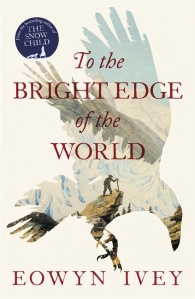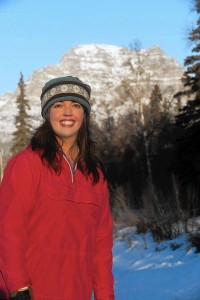 Eowyn Ivey was the author of my favourite book of 2012 and one of my all time favourite reads, her debut novel The Snow Child an extraordinary, accomplished work about a childless couple who leave the close-knit support of their child-filled families to try to make a success of ‘homesteading’ in the Alaska wilderness.
Eowyn Ivey was the author of my favourite book of 2012 and one of my all time favourite reads, her debut novel The Snow Child an extraordinary, accomplished work about a childless couple who leave the close-knit support of their child-filled families to try to make a success of ‘homesteading’ in the Alaska wilderness.
I’m not the only one who long-awaited the next thing she would write, a book that was first mentioned a couple of years ago, with the suggested title Shadow of the Wolverine and which would eventually be published in 2016 as To the Bright Edge of the World.
I reviewed this title for Bookbrowse, that review (not the same as my comments below) and an article I wrote about Lieutenant Henry Tureman Allen, can be viewed by members by clicking the link.

Set in 1885, Ivey’s new book was inspired by real events, and in particular by the adventures of the little known Lieutenant Henry Tureman Allen, an Alaskan Explorer and Decorated US Major General and his Report of an Expedition to the Copper, Tananá, and Kóyukuk Rivers.
The author also cites for inspiration Bram Stoker’s Dracula (first-person voices, use of documents and tremendous suspense), Mary Shelley’s Frankenstein (for its humanity in the face of terror and its time frame) and William Vollmann’s mythological fantasy The Ice-Shirt from the Seven Dream series.
It is narrated firstly through the letters and diary entries of the fictional Lieutenant Allen Forrestor (based on Henry Allen) and his younger wife Sophie, as he makes a commissioned expedition through harsh US owned Alaskan territory up the fictitious Wolverine River, with a small team accompanying him.
His wife Sophie writes him letters and keeps a journal of her time while he is away, so she can share how she spent her time. Sophie is both a woman of her time and ahead of her time, she knows what is expected of her, but has married a man who she hopes accepts she has a mind and a curiosity of her own, a part of her that shall not be tamed.
She takes up photography, learning how to mix chemicals and process plates and spends hours observing birdlife, in some of the most exquisite passages, as she patiently waits to capture a singular event, that might express that moment of pure magic she does not have the words to define, but can recognise instantly in an image, rare though it may be.

The Team Who Inspired the Novel
In contemporary time, we also read letters between a descendant of Allen Forrestor named Walter Forrester, who has sent the Colonel’s journals, papers and other items for safekeeping to Josh, the exhibitions curator of the Alpine Historical Museum in Alaska, hoping to convince him to safeguard the documents and artefacts, given they are some of the earliest, firsthand descriptions of those northern lands before colonisation, while still inhabited by native Midnooskies (a Russian word for “people of the Copper River”) and Wolverine River Indians (Ahtna and Eyak tribes).
While it is a novel, the journey upriver was inspired by the expedition of Lieutenant Henry T. Allen (1859 – 1930), a true account Eowyn Ivey came across when the bookshop she worked for acquired a rare copy of Allen’s Report of their Expedition to the Copper, Tanana, and Koyukuk Rivers in the Territory of Alaska.
Ivey took the book home for an evening, staying up late to read it, sharing passages with her husband and was completely fascinated by this piece of Alaskan history she had never heard of before, despite growing up and living all her life there.
In 1885, Allen and two men trekked up the Copper River into completely unmapped territory and encountered Native Alaskans who had never seen white people. The men nearly died many times from starvation and exposure, but eventually they made it through the mountains, down the Yukon River and to Saint Michael.
Though inspired by the Colonel’s expedition, the novel is influenced by other encounters and ancient beliefs she became aware of over time, and it was then the idea for the novel developed:
And at some point it struck me—what if a landscape actively reflected the beliefs of its people? And when these military men ventured into Alaska, what if they had encountered those beliefs as living, breathing, tangible forces?
 And in a style true to Eowyn Ivey and familiar from her novel The Snow Child (inspired by both a fairy tale and her own life), The Bright Edge of the World might be described she says, as “documentary meets mythology” where certain things the men encounter, they will fail to be able to explain, despite the fact that they all witnessed them. They are things the natives accept and speak of openly, but that these men have no words to describe and are somewhat reluctant to mention.
And in a style true to Eowyn Ivey and familiar from her novel The Snow Child (inspired by both a fairy tale and her own life), The Bright Edge of the World might be described she says, as “documentary meets mythology” where certain things the men encounter, they will fail to be able to explain, despite the fact that they all witnessed them. They are things the natives accept and speak of openly, but that these men have no words to describe and are somewhat reluctant to mention.
It is a novel that charts out the recent history of this relatively untamed wilderness and while recognising the beauty and simplicity of a way of life before armies, prospectors and settlers would change it forever, also looks back and recognises that if it were not for those who went first and documented what they found, little of that way of life would be known about and be able to be appreciated today.
The Colonel’s diaries, like the writings of Meriwether Lewis and Captain Cook, are a kind of cursed treasure.

Author, Eowyn Ivey
To the Bright Edge of the World is a wonderful introduction to a little known expedition that opened up further the Alaskan frontiers and a delightful story of a well matched couple, who manage to combine their love of nature and the outdoors with the way they live their lives.
Eowyn Ivey manages to inform and entertain in this worthy follow-up to the magical Snow Child, a novel that was always going to be a tough act to follow.
Click Here to Buy a Copy of To The Bright Edge of the World
Note: This book was an ARC (Advance Reader Copy), thank you to the publisher for providing a copy via NetGalley.

I like the sound of this, having an interest in stories that evoke a sense of place in interesting ways – especially little-known places like Alaska (to me, anyway).
LikeLiked by 1 person
Eowyn Ivey evokes the Alaskan wilderness so well, she is so well acquainted with it and as part of her research for this book, travelled upriver and spent nights in the wilderness, not to mention the years of fireside chats and hunting exploits of her husband which she often mentions and which inform her work. He is like a silent presence in her work. Have you read The Snow Child?
LikeLiked by 1 person
No, I haven’t. Another one to add to the pile!
LikeLiked by 1 person
Literary pleasure awaits you then!
LikeLiked by 1 person
Wonderful, gratifying review for an extraordinary novel, itself a treasure–but not a cursed one. Thank you, Claire!
LikeLiked by 1 person
Thank you, a treasure indeed, just as we had all hoped for. I hope we don’t have to wait four years for the next one.
LikeLike
Fantastic review Claire. I didn’t read The Snow Child (though it looks interesting), but this sounds right up my street and such a beautiful way of conveying the story by journal entries and letters, surely the inspiration Dracula gave. This sounds like an excellent book, definitely one I’d like to read.
LikeLiked by 1 person
Oh you must read The SNow Child, I think you’d love it, it’s such a beautifully written and moving story, the way she weaves a fascinating tale and the wilderness together and that tug between our need to hold on and natures way of insisting we let go, it’s both tender and tough at the same time. What a joy that you have still to read it.
LikeLiked by 1 person
I’ll definitely add it to the list Claire 🙂
LikeLiked by 1 person
The Snow Child was one of my favorites too. I love the mix of nature and mythology. I’ll be looking forward to reading this–thanks for the review.
LikeLiked by 1 person
Wasn’t it a fabulous read, just the right blend of everything great in a book for me. I hope you enjoy this one as much Deborah.
LikeLike
Like you I’ve been waiting on this since falling in love with The Snow Child which you put me onto. I bought it at the airport on my way out to Greece a few weeks ago – I planned to spend the week reading it in the sun. I started it on the flight and could barely put it down so it lasted only a little over a day and a half. I loved it – great story and beautifully written. I’ve since thought about which Of the two books I prefer but I’ve decided not to reach any conclusion on that – too difficult!!! – suffice to say I thought both books were wonderful and so I’ve started counting the years and months to Eowyn Ivey’s next book already!!
LikeLike
Oh yes, that is a preferable stance to take, to await her next book with ardent fervour than to have to choose between two extraordinary works so far.
LikeLike
I loved The Snow Child – this sounds excellent too – I love stories told through letters and diaries.
LikeLiked by 1 person
I still have to read The Snow Child! I do own it, so that’s half the battle. But, this one sounds great, too. I love reading about Arctic exploration.
LikeLike
Goodness, I still have The Snow Child in my book stack – I should probably start with that one!
LikeLike
Claire, I love this book, and I learned more about the author and the book’s inception from your fascinating post! Thank you!
LikeLike
Marvellous review, Claire, and one I shall be returning to when I finally get to read the book. I adored The Snow Child and To the Bright Edge of the World is my most eagerly awaited read of 2017!
LikeLike
First off thank you for getting me into The Snow Child in the first place. After reading Wasa Wasa, the idea of the wilderness up in that part of the world is bleak, yet fascinating…I can’t wait to read this in the cold days to come.
LikeLiked by 1 person